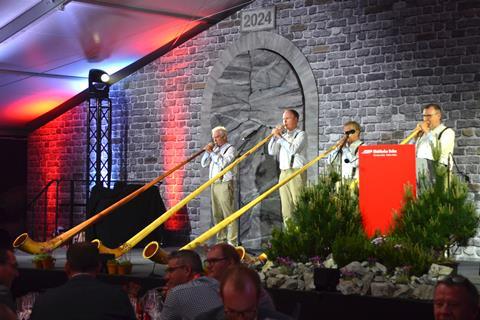
SWITZERLAND: More than 300 guests from the rail industry, politics, business and tourism attended opening celebrations held at both ends of Rhätische Bahn’s replacement Albula tunnel on June 8, ahead of the start of regular services on June 12.
The 5 860 m long Albula II tunnel at 1 821 m above sea level runs parallel to the original 5 864 m tunnel which opened in 1903 as part of the metre-gauge line between Thusis and St Moritz.
Trains are to cease using the older tunnel, which will be used as a safety tunnel accessed by 12 cross-passages from the new bore. Options for using it as a walking route are also being explored.
‘The new Albula tunnel is not only a technical masterpiece, but also a symbol of the continuation of traditions and values that have guided us since the founding of our canton’, Swiss Federal Council member for transport Dr Albert Rösti said at the opening ceremony.
‘The new tunnel stands for innovation and progress, characteristics that have always distinguished Graubünden and which also led to the construction of the old Albula tunnel in 1903 and the 19 042 m Vereina tunnel in 1999. These two north–south or south–north connections have made a significant contribution to the upswing of the Graubünden economy, to social life and to the preservation of cultural traditions.’
Replacement tunnel

Inspections of the original tunnel in 2006 found that major renovation works were needed.
After considering its options, in 2010 RhB decided that building a new tunnel to modern safety standards would be less disruptive than modernisation and not significantly more expensive.
Construction began in 2014 and cost SFr407m. Contractors included Porr Schweiz, Walo Bertschinger, Mettler Prader, Nicol Hartmann & Cie, Lazzarini, Pizzarotti and Züblin.
The new tunnel is designed for a maximum speed of 120 km/h, compared to 75 km/h in the old tunnel. Speaking to Railway Gazette International at the inauguration, RhB director Renato Fasciati said this will be important for the new timetable to be introduced in December which will feature shorter turnaround times at St Moritz.
Enhancements

Fasciati said ‘the most important project now’ is the ongoing modernisation of the Landquart station area where SFr600m is to be invested by 2032.
‘We have been working on various subprojects here since 2018’, he said. Double tracking has been completed between Landquart and Malans, the railway’s workshop facilities are being expanded, and in 2026-32 new tracks are to be laid in co-operation with Swiss Federal Railways to increase capacity and improve connections.
Another major project is the new Fideriser tunnel on the Landquart – Klosters line, where the rail and road routes are to be redesigned.
Fasciati said RhB’s 56th Stadler Capricorn multiple-unit had arrived on June 6, completing deliveries under its first two orders, and another six are to arrive by the end of 2026.
The first of the Ge4/4 III electric locomotives manufactured by SLM/ABB and Adtranz in 1993-99 is to be modernised by the second half of 2025, he added.
RhB recently purchased recently two Appenzeller Bahnen coaches to provide a short term capacity boost, and Fasciati said the procurement of new vehicles for the Bernina and Arosa routes is currently being planned.
- Subscribers can read an in-depth article on the Albula tunnel replacement project from the April 2023 issue of Railway Gazette International magazine.

















